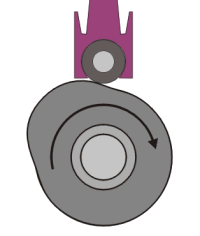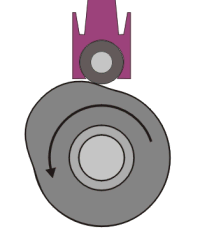|

|
Operational Information
Lost Motion
|
****JavaScript based drop down DHTML menu generated by NavStudio. (OpenCube Inc. - http://www.opencube.com)****
|
|
On a two stroke engine, the fuel pumps must be
retimed when the engine is required to reverse direction
(i.e. run astern). This is done by moving the fuel pump cams or fuel
pump cam follower positions relative to the crankshaft.
 |
If one cylinder of the engine is considered
(left), the piston is just before TDC with the engine running
ahead and the crankshaft rotating clockwise. The piston is
moving up towards TDC. The picture on the right shows the fuel
cam at this point; where the cam follower is rising up the lift
of the cam as it rotates clockwise. This point can be considered
as the start of injection.
|

The fuel pump cam follower is moving up the
rise of the cam on the delivery stroke. The cam is correctly in
time with the engine |
 |
If, at this point the engine is stopped, and is
started in the reverse direction (astern), the crankshaft now
moves in an anticlockwise direction. Then the piston in this
particular unit is now moving down the cylinder
and is just after TDC. At this point fuel injection should
have just finished. However, by studying the picture of the cam
(right) it can be seen that the camshaft has reversed direction
(because it is directly driven from the crankshaft), and is also
rotating anticlockwise.
In the picture the follower is moving down the cam
which means the fuel pump plunger is just finishing the suction
stroke; i.e completely out of time with the
engine.
|

Here the fuel pump cam is in the wrong
position. When the piston is just after TDC, fuel delivery should
have finished and the follower should be approaching the peak of
the cam. |
 |
So that the Fuel Pump cam is timed correctly with
the crankshaft when the engine is reversed, the fuel pump cams are
rotated by a hydraulic servomotor which changes the position of
the cams relative to the crankshaft. The angle through which the
cams are turned is known as the Lost Motion angle.
Although this can be made to happen when the engine is still
rotating, it is probably easier to think of the engine stopped
as shown left and the camshaft moving as shown on the animation below.
Once the fuel cams have moved, the engine can then start running
in the reverse direction (anticlockwise).

Because the engine is started using compressed air admitted
through the air start valves, the operating mechanism for these
must also be retimed.
More details on the operation of the reversing servomotor as
used on the Sulzer RTA engine can be found in the
members section |


The angle that the cams move through is the
lost motion angle.
|
This is not the only method of reversing a two stroke
engine. Other methods include moving the whole camshaft axially so that
a different set of cams are used, and a rather clever method used by
MAN-B&W which alters the position of the cam followers.
In case you are wondering, it is not necessary
to retime the exhaust valve operating cams on a Two Stroke
engine. Think about it!!
If you can't work out why,
click here




|








